-
ORIGINAL ARTICLE12-16-2024
Childbirth care by health professionals: conflicting practices in obstetrics
Revista Brasileira de Enfermagem. 2024;77(6):e20230129
Abstract
ORIGINAL ARTICLEChildbirth care by health professionals: conflicting practices in obstetrics
Revista Brasileira de Enfermagem. 2024;77(6):e20230129
DOI 10.1590/0034-7167-2023-0129
Views0See moreABSTRACT
Objectives:
to understand the perceptions of women and health professionals regarding childbirth care at a teaching hospital in the western state of Paraná, Brazil.
Methods:
this qualitative study employed Grounded Theory, conducted in an obstetric care service with 38 participants (women and health professionals) through semi-structured interviews.
Results:
limitations in physical infrastructure and management of care, along with the women’s limited knowledge about the childbirth process and the decision-making and guidance of professionals, show conflicting obstetric practices-a discrepancy between good practices and obstetric violence. Training in obstetric nursing and active participation in care, alongside the presence of a companion, were identified as intervening conditions and strategies in the process.
Final Considerations:
childbirth care is characterized by dichotomous practices. While some professionals base their practices on scientific evidence, others rely on teachings and experiences from the time of their training.
-
12-16-2024
Religión y experiencia profesional: ¿Serán predictores de la inteligencia espiritual de los enfermeros? Estudio transversal
Revista Brasileira de Enfermagem. 2024;77(6):e20240217
Abstract
Religión y experiencia profesional: ¿Serán predictores de la inteligencia espiritual de los enfermeros? Estudio transversal
Revista Brasileira de Enfermagem. 2024;77(6):e20240217
DOI 10.1590/0034-7167-2024-0217es
Views1See moreRESUMEN
Objetivos:
analizar la relación entre religión y experiencia profesional con la inteligencia espiritual en enfermeros.
Métodos:
estudio transversal y analítico realizado en 2021, participaron 544 profesionales de enfermería que laboraban en establecimiento de salud de Perú durante la pandemia por COVID-19. Para el análisis de los datos se emplearon el análisis de regresión múltiple y correlación de Pearson.
Resultados:
en los enfermeros predominó un nivel de inteligencia espiritual saludable (42,8%). Quienes no profesaban una religión tenían mayor probabilidad de tener menor puntaje de inteligencia espiritual (escala global y dimensiones); sin embargo, los enfermeros expertos tuvieron mayor probabilidad de tener mayor inteligencia espiritual (escala global y dimensiones) que los enfermeros novatos (p<0,05).
Conclusiones:
la inteligencia espiritual en los enfermeros fue predicha por la religión y la experiencia profesional. Este hallazgo sugiere que la inteligencia espiritual en enfermería se consolida mediante prácticas religiosas y durante el ejercicio profesional.
-
12-16-2024
A relação entre gênero, formação educacional e ambiente de aprendizagem com a ansiedade do estudante de enfermagem
Revista Brasileira de Enfermagem. 2024;77(6):e20220615
Abstract
A relação entre gênero, formação educacional e ambiente de aprendizagem com a ansiedade do estudante de enfermagem
Revista Brasileira de Enfermagem. 2024;77(6):e20220615
DOI 10.1590/0034-7167-2022-0615
Views1See moreRESUMEN
Objetivos:
identificar las variables asociadas a la práctica clínica relacionadas con la ansiedad de los estudiantes de enfermería.
Métodos:
se utilizó un diseño descriptivo, cuantitativo, correlacional con las recomendaciones STROBE, EQUATOR. La población fue de 233 estudiantes de enfermería con una muestra de 135 personas. Los datos se recopilaron de marzo a abril de 2022 utilizando instrumentos validados.
Resultados:
la prueba de chi-cuadrado y razón de verosimilitud significativa para género, formación académica y entorno de aprendizaje son superiores a 0.05, por lo que no existe una relación significativa entre las variables y la ansiedad de los estudiantes.
Conclusiones:
los estudiantes necesitan prepararse nuevamente antes de ingresar al campo de la práctica. Investigaciones cualitativas también son necesarias.
-
ORIGINAL ARTICLE12-16-2024
Bladder ultrasound: evidence of content validity of a checklist for training nurses
Revista Brasileira de Enfermagem. 2024;77(6):e20230183
Abstract
ORIGINAL ARTICLEBladder ultrasound: evidence of content validity of a checklist for training nurses
Revista Brasileira de Enfermagem. 2024;77(6):e20230183
DOI 10.1590/0034-7167-2023-0183
Views0See moreABSTRACT
Objectives:
to develop and analyze evidence of content validity of a checklist for training nurses in measuring bladder volume through ultrasound.
Methods:
a methodological study, consisting of three stages: literature review; instrument item preparation; and analysis of evidence of content validity. The Content Validity Index (CVI) and Gwet’s AC2 were used for content validity analyses.
Results:
the checklist consisted of 23 items. The CVIs for clarity, relevance and dimensionality were 0.99, 0.99 and 0.98 respectively, and the CVIs for Gwet’s AC2 with coefficients for clarity, relevance and dimensionality were 0.89, 0.97 and 0.95, respectively, with p<0.001.
Conclusions:
the checklist developed for training nurses in measuring bladder volume through ultrasound achieved adequate evidence of content validity, and can be used to train nurses in clinical practice and future research.
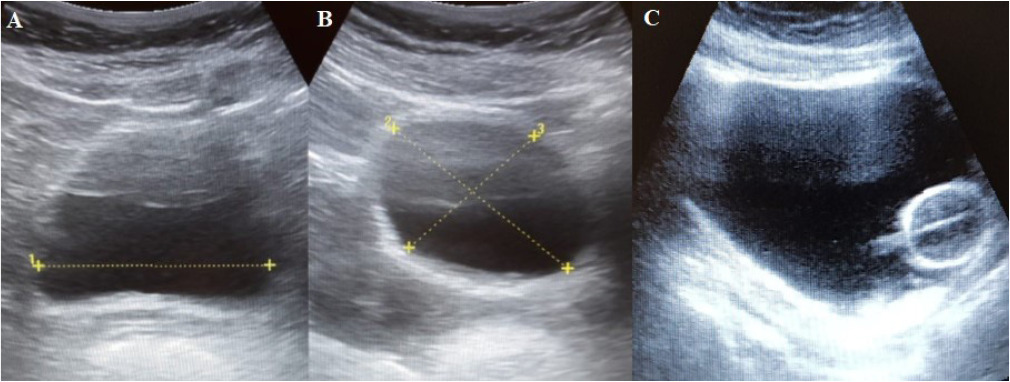
-
ORIGINAL ARTICLE12-16-2024
Nursing team’s perceptions about care for pregnant women in a psychiatric unit
Revista Brasileira de Enfermagem. 2024;77(6):e20230186
Abstract
ORIGINAL ARTICLENursing team’s perceptions about care for pregnant women in a psychiatric unit
Revista Brasileira de Enfermagem. 2024;77(6):e20230186
DOI 10.1590/0034-7167-2023-0186
Views0See moreABSTRACT
Objectives:
to understand the nursing team’s perception in relation to the care provided to pregnant women with mental disorders admitted to a psychiatric hospital unit.
Methods:
Convergent Care Research carried out between August and December 2021, through semi-structured interviews with 25 nursing professionals from a Psychiatric Unit from a reference Hospital in Southern Brazil.
Results:
the organized and analyzed data resulted in two thematic categories: Technical, generic and impersonal care; and From impersonality to the singularity of nursing care. Ensuring unique care for pregnant women with mental disorders means giving them a meaning of existence and providing care from a multidimensional and continuous perspective.
Final Considerations:
nursing care for pregnant women in psychiatric hospitalization requires continuous professional qualification, interactive technologies and support for the nursing process, in addition to promoting singular and multidimensional care.
-
ORIGINAL ARTICLE12-16-2024
The nursing practice environment and hospital sociotechnical complexity: a mixed-methods study
Revista Brasileira de Enfermagem. 2024;77(6):e20230315
Abstract
ORIGINAL ARTICLEThe nursing practice environment and hospital sociotechnical complexity: a mixed-methods study
Revista Brasileira de Enfermagem. 2024;77(6):e20230315
DOI 10.1590/0034-7167-2023-0315
Views1See moreABSTRACT
Objectives:
to analyze the relationship between the nursing practice environment and hospital sociotechnical complexity as perceived by nurses.
Methods:
a sequential explanatory mixed-methods study was conducted in a hospital in southern Brazil. The Brazilian version of the Practice Environment Scale-Nursing Work Index and the Complexity Characterization Questionnaire were administered to 132 nurses. Subsequently, semi-structured interviews were conducted with 18 participants, and the data were subjected to thematic analysis. Data integration was achieved through a connection approach.
Results:
the nursing practice environment was found to be favorable, except in the subscale concerning Staffing and Resource Adequacy, where complexity was present in the activities. The three emerging categories explained human and technical aspects related to complexity in the practice environment, quality of care, and patient safety. Unexpected variability was inversely correlated with the practice environment.
Conclusions:
the study results indicate a relationship between these constructs, with implications for the quality and the safety of care.
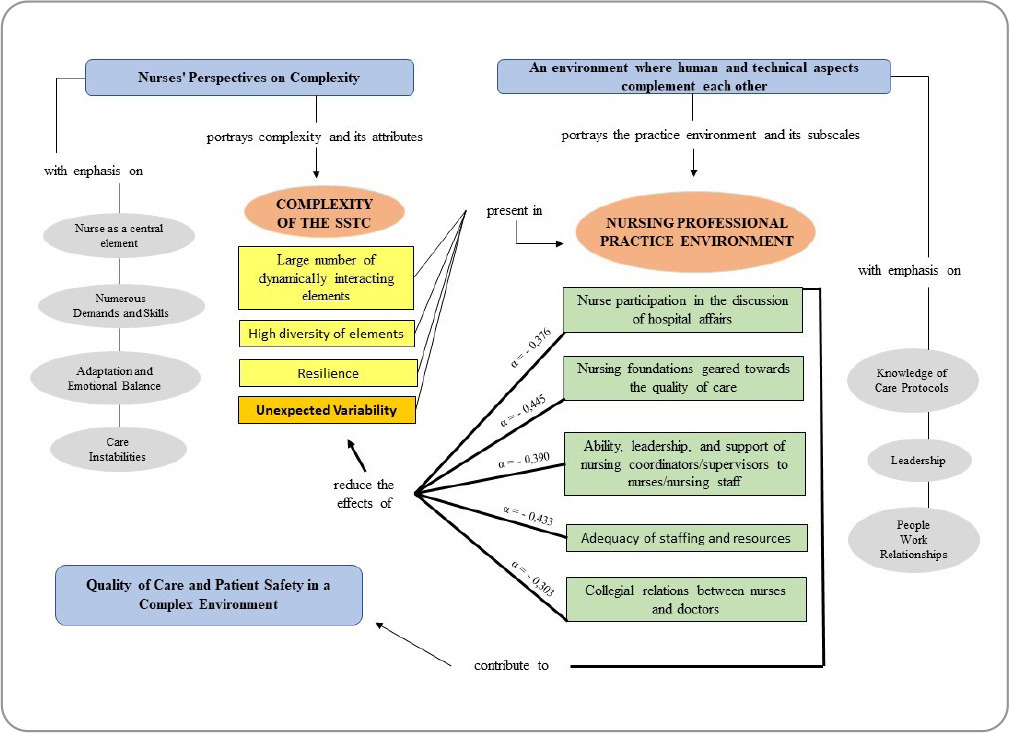
-
ORIGINAL ARTICLE12-16-2024
Factors associated with maternal well-being during childbirth among postpartum women in Minas Gerais
Revista Brasileira de Enfermagem. 2024;77(6):e20230304
Abstract
ORIGINAL ARTICLEFactors associated with maternal well-being during childbirth among postpartum women in Minas Gerais
Revista Brasileira de Enfermagem. 2024;77(6):e20230304
DOI 10.1590/0034-7167-2023-0304
Views0See moreABSTRACT
Objectives:
to analyze the factors associated with maternal well-being during childbirth among postpartum women in Minas Gerais.
Methods:
a cross-sectional study nested within a cohort was conducted with postpartum women in a municipality of Minas Gerais. The Maternal Well-being in Childbirth Scale 2 was used. The prevalence of maternal well-being during childbirth was estimated. The magnitude of the association between maternal distress and care practices was estimated using the Prevalence Ratio (PR), applying Poisson regression.
Results:
a total of 183 postpartum women aged between 15 and 46 years participated, with 26.2%, 27.9%, and 45.9% reporting excellent, adequate, and poor well-being during childbirth care, respectively. Maternal distress was more prevalent among women who underwent cesarean sections (PR = 1.60) and those who did not receive breastfeeding information (PR = 1.59).
Conclusions:
a high prevalence of maternal distress during childbirth was observed, associated with cesarean delivery and the lack of breastfeeding information.
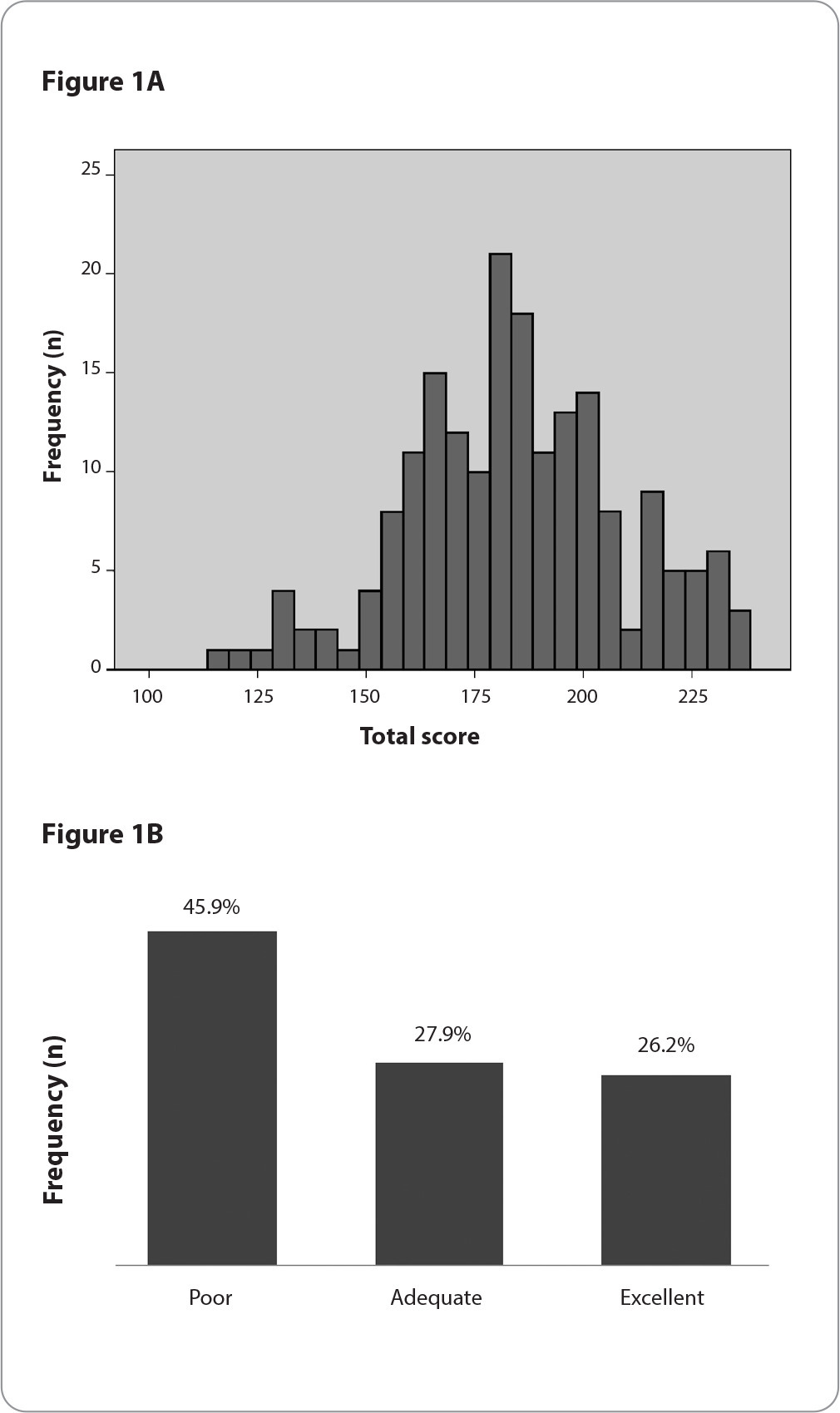
-
ORIGINAL ARTICLE12-16-2024
Prevalence and factors associated with musculoskeletal pain among hospital cleaning staff
Revista Brasileira de Enfermagem. 2024;77(6):e20230237
Abstract
ORIGINAL ARTICLEPrevalence and factors associated with musculoskeletal pain among hospital cleaning staff
Revista Brasileira de Enfermagem. 2024;77(6):e20230237
DOI 10.1590/0034-7167-2023-0237
Views0See moreRESUMO
Objetivos:
verificar a prevalência e os fatores associados à dor musculoesquelética em trabalhadores do serviço hospitalar de limpeza.
Métodos:
estudo transversal, realizado com trabalhadores de limpeza de um hospital de ensino do Sul do Brasil. Utilizaram-se questionário com variáveis sociodemográficas, laborais e de saúde, o Nordic Musculoskeletal Questionnaire e o Diagrama de Corlett e Manenica. Realizou-se análise bivariada.
Resultados:
participaram 149 trabalhadores. Prevaleceu dor musculoesquelética na coluna lombar no último ano (65,8%) e últimos sete dias (42,3%). Constataram-se associações entre automedicação e dor na parte inferior das costas (p=0,020) e ombros (p=0,026); sedentarismo, oito horas de sono diárias e dor nos tornozelos (p=0,041) e pés (p=0,039); ex-tabagismo, uso de medicamento e dor nos punhos (p=0,015) e mãos (p=0,004).
Conclusões:
prevaleceram lombalgias associadas a hábitos de saúde e vida. Um programa de educação em saúde e recomendações de melhorias nos processos de trabalho podem minimizar a exposição à dor musculoesquelética.
-
REVIEW06-10-2022
Self-inflicted violence and suicide in people living with HIV/AIDS: a systematic review
Revista Brasileira de Enfermagem. 2022;75:e20210768
Abstract
REVIEWSelf-inflicted violence and suicide in people living with HIV/AIDS: a systematic review
Revista Brasileira de Enfermagem. 2022;75:e20210768
DOI 10.1590/0034-7167-2021-0768
Views0See moreABSTRACT
Objectives:
to analyze intellectual productions on self-inflicted violence and suicide in people living with HIV/AIDS.
Methods:
a systematic review, carried out between March and April 2021, in the PubMed®/MEDLINE®, Web of Science and LILACS databases, subsidized in the Strengthening the Reporting of Observational Studies in Epidemiology. The period outlined was from 2011 to 2020.
Results:
a total of 199 studies were identified, and 16 composed the final sample, grouped into the categories: Sociodemographic characteristics of victims of self-inflicted violence/suicide and their intervening factors (pointing to young adults, especially homosexuals, with low social support and a history of mental illness or substance abuse as usual victims); Successful measures for suicide prevention/control in people living with HIV/AIDS (suggesting more frequent psychosocial and clinical follow-up of those starting antiretroviral and immunocompromised treatment).
Conclusions:
biopsychosocial follow-up, analysis of sociodemographic profile and intervening factors should be frequent in this population for disease prevention/control.

-
ORIGINAL ARTICLE09-05-2022
Screening for common mental disorder in elderly residents in the countryside: a cross-sectional study
Revista Brasileira de Enfermagem. 2022;75:e20210875
Abstract
ORIGINAL ARTICLEScreening for common mental disorder in elderly residents in the countryside: a cross-sectional study
Revista Brasileira de Enfermagem. 2022;75:e20210875
DOI 10.1590/0034-7167-2021-0875
Views0See moreABSTRACT
Objective:
To estimate the prevalence of common mental disorders and their associated factors in the elderly in a municipality in the countryside of the Brazilian Midwest.
Methods:
Quantitative, observational, cross-sectional approach research, conducted with 218 elderly people.
Results:
The prevalence of the common mental disorder among the elderly was 25.1%; in the univariate analysis, it was higher in females (35.4%), in the age group of 80 years or older (46.1%), brown skin color (30.2%), widowed (42.6%), illiterate (47.6%), and retired (27.6%). In the multiple analysis, the variables female gender (p<0.006), age 80 years or older (p<0.036), dissatisfaction with life (p<0.009), lack of social interaction (p=0.017), and dysfunctional family (p=0.021) remained associated with CMD.
Conclusion:
The results revealed are helpful and contribute to the reinforcement of the need for mental health care in this population extract so growing worldwide.
-
ORIGINAL ARTICLE06-03-2022
Association between falls in older adults and prevention group
Revista Brasileira de Enfermagem. 2022;75:e20200207
Abstract
ORIGINAL ARTICLEAssociation between falls in older adults and prevention group
Revista Brasileira de Enfermagem. 2022;75:e20200207
DOI 10.1590/0034-7167-2020-0207
Views0See moreABSTRACT
Objectives:
to assess the effectiveness of guidelines on fall prevention in a group of older adults in Primary Health Care.
Methods:
a cross-sectional study, carried out with older adults selected by a simple random sample (274; N=1,234). Data covered sociodemographic and socioeconomic variables, marital status, health conditions, factors associated with falls and participation in the prevention group. Student’s t test was used, and dichotomous variables were used by the chi-square test. The project met ethical requirements.
Results:
sample with female profile (61.7%), married, with low education, mean age of 71.69 years. The factors associated with falls identified were female sex, medicalization and participation in the prevention group. There was no protective association between participation in a fall prevention group in older adults and a decrease in the number of falls.
Conclusions:
based on evidence, a personalized intervention during the nursing visit is suggested as a strategy to prevent falls.

-
ORIGINAL ARTICLE03-07-2022
Predictors of frailty in older people users of Primary Health Care
Revista Brasileira de Enfermagem. 2022;75:e20201292
Abstract
ORIGINAL ARTICLEPredictors of frailty in older people users of Primary Health Care
Revista Brasileira de Enfermagem. 2022;75:e20201292
DOI 10.1590/0034-7167-2020-1292
Views0See moreABSTRACT
Objective:
to identify the prevalence and predictors of frailty in older people in Primary Health Care.
Method:
this is a descriptive and correlational study, carried out in a convenience sample of 136 older people in the community. Data were collected through a sociodemographic and clinical questionnaire and frailty phenotype. Student’s t test or U-Mann-Whitney test, chi-square and binary logistic regression were used for data analysis.
Results:
the prevalence of frailty was 26.5% (n=36). Frail individuals had older age (p=0.011), worse self-rated health (p=0.001) and lower physical capacity (p<0.001). In the multivariable regression, it was observed that frail individuals had older age (Odds Ratio=1.111; 95% confidence interval=1.026-1.203) and worse physical capacity (Odds Ratio=0.673; 95% confidence interval=0.508-0.893).
Conclusions:
the prevalence of frailty in older people in Primary Health Care was considerable. Advanced age and worse physical capacity were the most relevant predictors of frailty in the elderly.
-
ORIGINAL ARTICLE04-15-2022
Validation of Questionnaire to Assess the Impact of Dementia on the Family
Revista Brasileira de Enfermagem. 2022;75:e20210232
Abstract
ORIGINAL ARTICLEValidation of Questionnaire to Assess the Impact of Dementia on the Family
Revista Brasileira de Enfermagem. 2022;75:e20210232
DOI 10.1590/0034-7167-2021-0232
Views0See moreABSTRACT
Objective:
To validate a questionnaire to assess the impact of dementia on one of the household members.
Methods:
Methodological study. The instrument was designed based on literature review, expert opinion, and researchers’ experience and then applied to a non-probability convenience sample consisting of 262 family members who live daily with a person with dementia. The construct validity was studied by exploratory factor analysis, principal components method, with varimax rotation of the items.
Results:
An instrument with 30 items was obtained, distributed in four dimensions: “Emotional dimension,” “Economic dimension,” “Family relations dimension,” and “Support-seeking dimension.” Factor analysis revealed a total explained variance of 54.96% and a total Cronbach’s alpha of .899.
Conclusions:
The instrument presents high internal consistency, grouped into four dimensions, all closely related to the family’s adaptation to the onset of dementia in one of its members.
-
ORIGINAL ARTICLE03-07-2022
Is self-esteem associated with the elderly person’s quality of life?
Revista Brasileira de Enfermagem. 2022;75:e20210388
Abstract
ORIGINAL ARTICLEIs self-esteem associated with the elderly person’s quality of life?
Revista Brasileira de Enfermagem. 2022;75:e20210388
DOI 10.1590/0034-7167-2021-0388
Views0See moreABSTRACT
Objective:
To analyze the association between self-esteem and quality of life in the elderly.
Methods:
Cross-sectional web survey developed with 519 elderly people. Participants filled out three data collection instruments developed on the Google Forms platform and widely disseminated through all of Brazil. Fisher’s exact test, Mann-Whitney, Pearson correlation, and linear regression with 95% confidence interval were used.
Results:
Self-esteem was associated with all quality-of-life facets: sensory skills [β= 1.307; p<0.001]; autonomy [β= 2.101; p<0.001]; past, present, and future activities [β= 2.486; p<0.001]; social presence [β= 2.547; p<0.001]; death and dying [β= 2.175; p<0.001]; and intimacy [β=2.378; p<0.001].
Conclusion:
There is a positive and statistically significant association between self-esteem and quality of life in the elderly. We therefore suggest the development of local policies capable of raising this age groups’ self-esteem and reaffirming aging as a new possibility for discoveries and pleasure.
-
EXPERIENCE REPORT10-24-2022
Nursing process for elderly women susceptible to falls from the perspective of the Pender’s Model
Revista Brasileira de Enfermagem. 2022;75:e20210913
Abstract
EXPERIENCE REPORTNursing process for elderly women susceptible to falls from the perspective of the Pender’s Model
Revista Brasileira de Enfermagem. 2022;75:e20210913
DOI 10.1590/0034-7167-2021-0913
Views0See moreABSTRACT
Objectives:
to describe the strategy of applying the nursing process guided by Pender’s Health Promotion Model to elderly women susceptible to falls with a view to promoting a self-efficacy behavior for fall prevention.
Methods:
application of the nursing process to eleven elderly women who had already experienced falls, living in a neighborhood in the outskirts of Belem, state of Pará, which involved interviews to obtain their nursing history and group meetings using the focus group technique to develop the other phases of the nursing process: nursing diagnosis, nursing interventions, and nursing assessment.
Results:
despite the risk factors for falls, the intervention model adopted in this study allowed elderly women to enhance their self-efficacy.
Final Considerations:
the model proved to be suitable for the participation of elderly women in actions to build fall prevention behaviors, with a view to healthier lifestyles.

-
ORIGINAL ARTICLE10-24-2022
Factors associated with symptoms of physical and emotional burden in informal caregivers of the elderly
Revista Brasileira de Enfermagem. 2022;75:e20210927
Abstract
ORIGINAL ARTICLEFactors associated with symptoms of physical and emotional burden in informal caregivers of the elderly
Revista Brasileira de Enfermagem. 2022;75:e20210927
DOI 10.1590/0034-7167-2021-0927
Views1See moreABSTRACT
Objectives:
to analyze the personal and work-related burden factors associated with physical and emotional symptoms of informal caregivers of the elderly.
Methods:
cross-sectional study conducted with 121 informal caregivers and 121 seniors who received care, assessed individually for the risk of: physical overload, musculoskeletal symptoms, Self-Reporting Questionnaire, effort perception, and Katz index.
Results:
a greater perception of effort raises up to 3.3 times the chances of presenting symptoms of pain in the spine region (p=0.01), and lower functional capacity of the elderly increases up to 1.3 times the chances of presenting pain symptoms in the spine region (p=0.02). The symptoms of emotional overload were associated with the caregiver’s low income (p=0.02).
Conclusions:
the perception of effort, dependence of the elderly, caregiver’s age, and symptoms of emotional overload are involved with caregivers’ symptoms of physical overload, and low income, with emotional overload.
-
ORIGINAL ARTICLE05-21-2021
Prevalence and factors associated with acute kidney injury in patients in intensive care units
Revista Brasileira de Enfermagem. 2021;74(2):e20200790
Abstract
ORIGINAL ARTICLEPrevalence and factors associated with acute kidney injury in patients in intensive care units
Revista Brasileira de Enfermagem. 2021;74(2):e20200790
DOI 10.1590/0034-7167-2020-0790
Views0See moreABSTRACT
Objectives:
to identify the prevalence and factors associated with the development of acute kidney injury in critically ill patients.
Methods:
a cross-sectional study, conducted from June 2018 to August 2019. The Kidney Disease Improving Global Outcomes was used to classify acute kidney injury. A significant value was set at p<0.05.
Results:
a total of 212 patients were included, of whom 35.8% evolved into an acute kidney injury. Patients with acute kidney injury had hypertension, higher levels on severity scores and a higher baseline creatinine rate> 1.5 mg/dL, also, when applied logistic regression, were 7 times more likely to develop acute kidney injury, Odds Ratio 7.018. More than half (56.6%) of the patients with acute kidney injury died. Moreover, 26.7% of these patients developed pressure sore.
Conclusions:
the prevalence of kidney injury was high (35.8%). The patients who developed it had a higher severity, mortality, and pressure sore index.
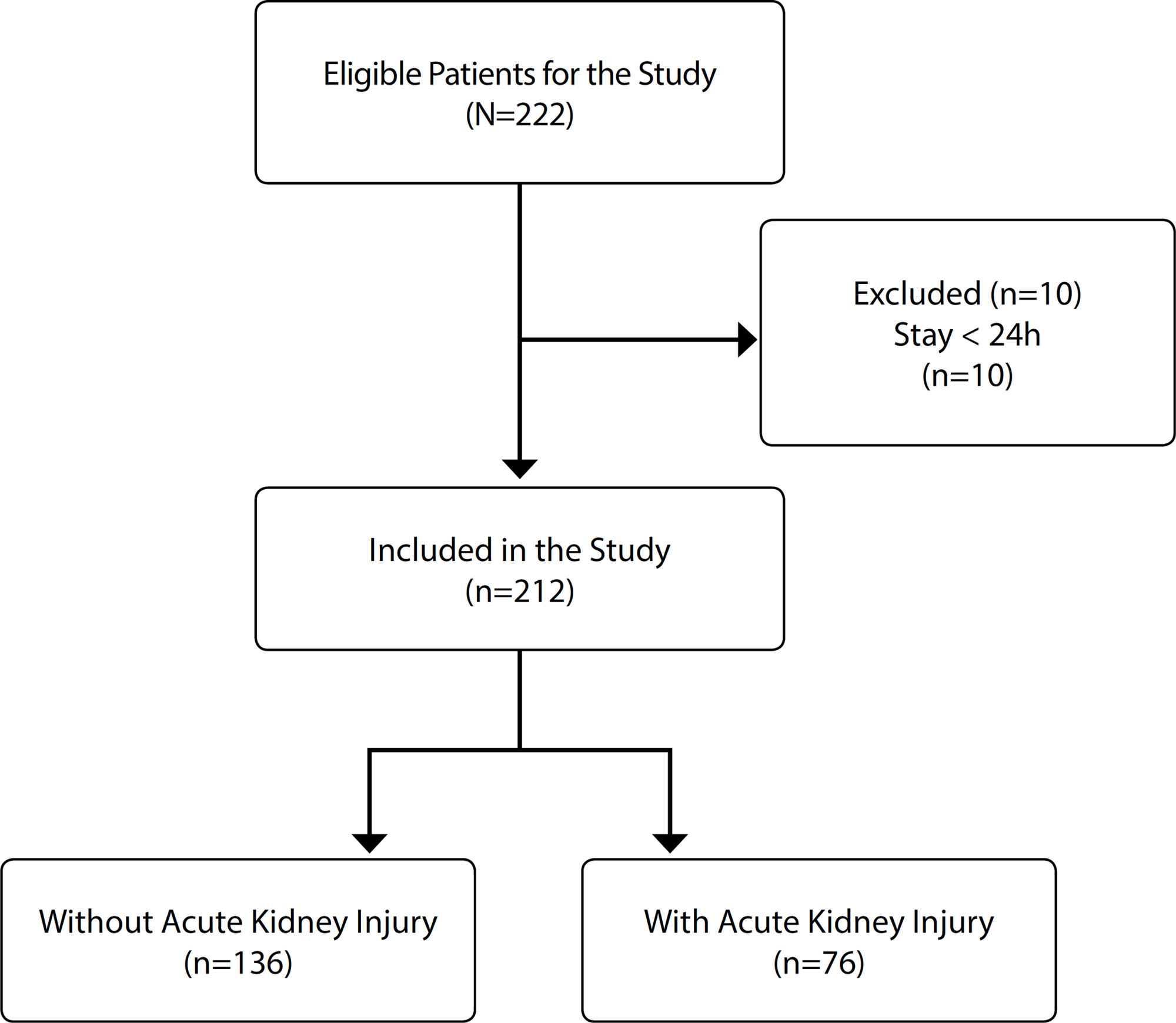
-
ORIGINAL ARTICLE08-08-2022
Social and territorial inequalities in the mortality of children and adolescents due to COVID-19 in Brazil
Revista Brasileira de Enfermagem. 2022;75(6):e20210482
Abstract
ORIGINAL ARTICLESocial and territorial inequalities in the mortality of children and adolescents due to COVID-19 in Brazil
Revista Brasileira de Enfermagem. 2022;75(6):e20210482
DOI 10.1590/0034-7167-2021-0482
Views0See moreABSTRACT
Objective:
To analyze the mortality rate of COVID-19 among children and adolescents aged 0 to 14 years.
Methods:
Ecological and exploratory study of children’s mortality rate by COVID-19 in Brazil, from February to October 2020. The study used the Severe Acute Respiratory Syndrome database to collect the data and made the analysis using descriptive spatial statistics by age and race/color classification.
Result:
The mortality rate due to COVID-19 represented 1.34 deaths per one hundred thousand in the total group evaluated. The age group with the highest frequency and mortality rate was 1 to 4 years of age. There is a higher frequency of deaths in the brown and Indigenous population.
Conclusion:
The distribution of deaths due to COVID-19 is unequal in the national territory, and there is a wide variation in the mortality rate by age and race/color groups.
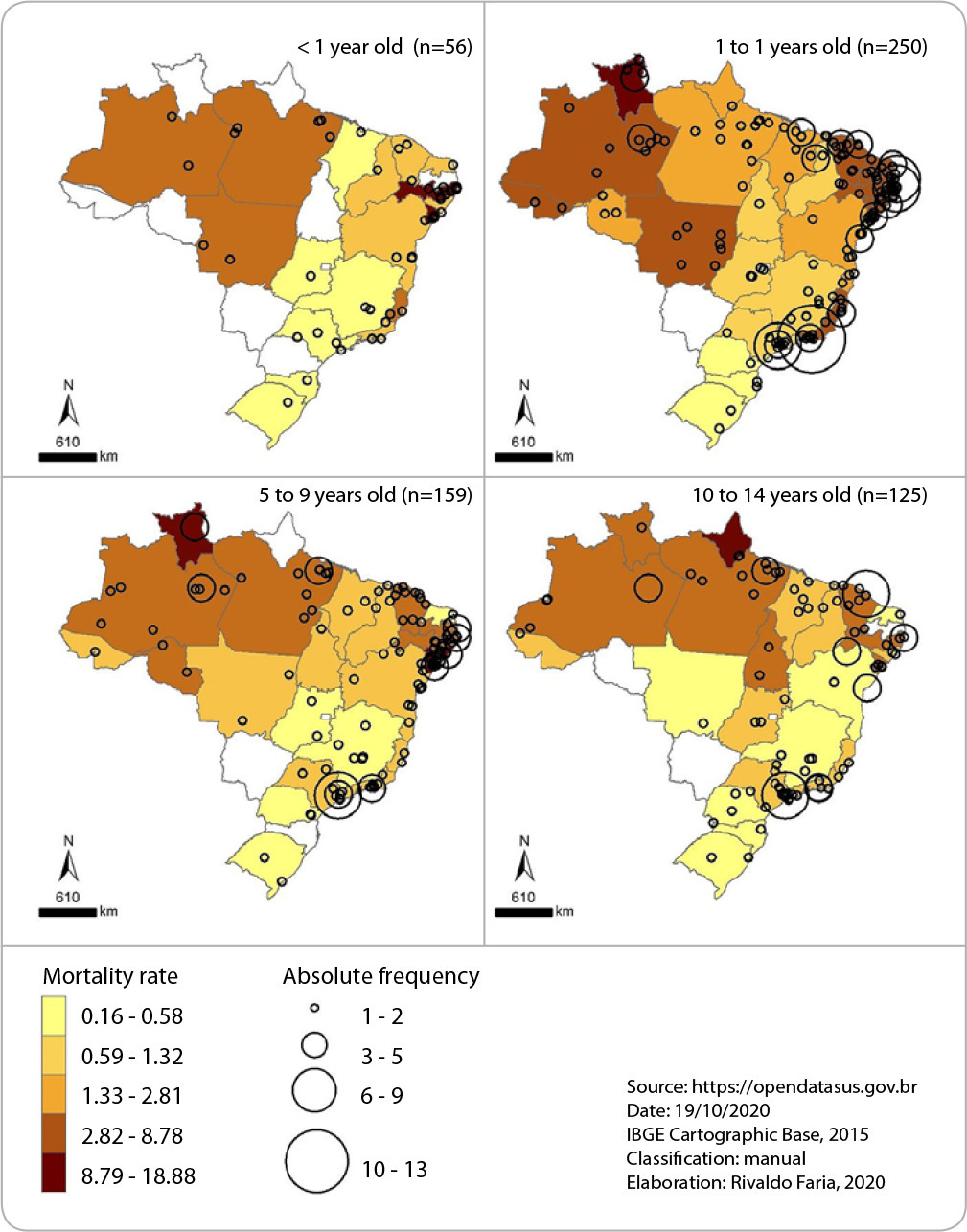
-
ORIGINAL ARTICLE06-09-2021
Professional practice in caring for maternal grief in the face of stillbirth in two countries
Revista Brasileira de Enfermagem. 2021;74(3):e20200253
Abstract
ORIGINAL ARTICLEProfessional practice in caring for maternal grief in the face of stillbirth in two countries
Revista Brasileira de Enfermagem. 2021;74(3):e20200253
DOI 10.1590/0034-7167-2020-0253
Views0See moreABSTRACT
Objective:
to understand professional care for maternal grief in the puerperium of stillbirth.
Methods:
a clinical-qualitative study with all the women who had stillbirths living in Maringá (Brazil) and participating in the Center d’Études et de Recherche in Family Intervention at the University of Quebec in Outaouais in Gatineau (Canada). Semi-structured interviews were carried out and the relevant aspects were categorized into themes.
Results:
the identified categories were: Assistance received in the puerperium with a focus on grief: hospital and outpatient environment, and Professional support in coping with maternal grief after fetal loss: with contact and memories, without contact and without memories and impossibilities of contact with the baby.
Final
considerations: the need for a multidisciplinary support and monitoring network for women who experienced fetal loss was evident. From this study, a routine of care for grief can be implemented in Brazil based on experiences in Canada.
-
ORIGINAL ARTICLE06-18-2021
Standard drug consumption: a study with elderly people in Primary Health Care
Revista Brasileira de Enfermagem. 2021;74(3):e20200729
Abstract
ORIGINAL ARTICLEStandard drug consumption: a study with elderly people in Primary Health Care
Revista Brasileira de Enfermagem. 2021;74(3):e20200729
DOI 10.1590/0034-7167-2020-0729
Views0See moreABSTRACT
Objective:
To identify the pattern of medication consumption among the elderly assisted in Primary Health Care.
Methods:
Descriptive, quantitative, cross-sectional study, with a sample of 315 elderly people, in a city in rural Rio Grande do Norte.
Results:
The average age was 72.41 years, with an average consumption of 3.15 medications per day, ranging from 1 to 16 medications daily. There was a prevalence of antihypertensives, antidiabetics, hypolipidemic and psychotropic drugs. 238 different drugs were mentioned, 15 of which were “potentially inappropriate drugs” for the elderly. Most of these patients follow treatment according to medical prescription, with low self-medication. Most elderly people buy their drugs, although many are available for free.
Conclusion:
The most consumed drugs are consistent with the most reported diseases (hypertension and diabetes). The daily use of inappropriate medications for the elderly is worrying, especially psychotropics, given the risks of dependence or health complications of these users.
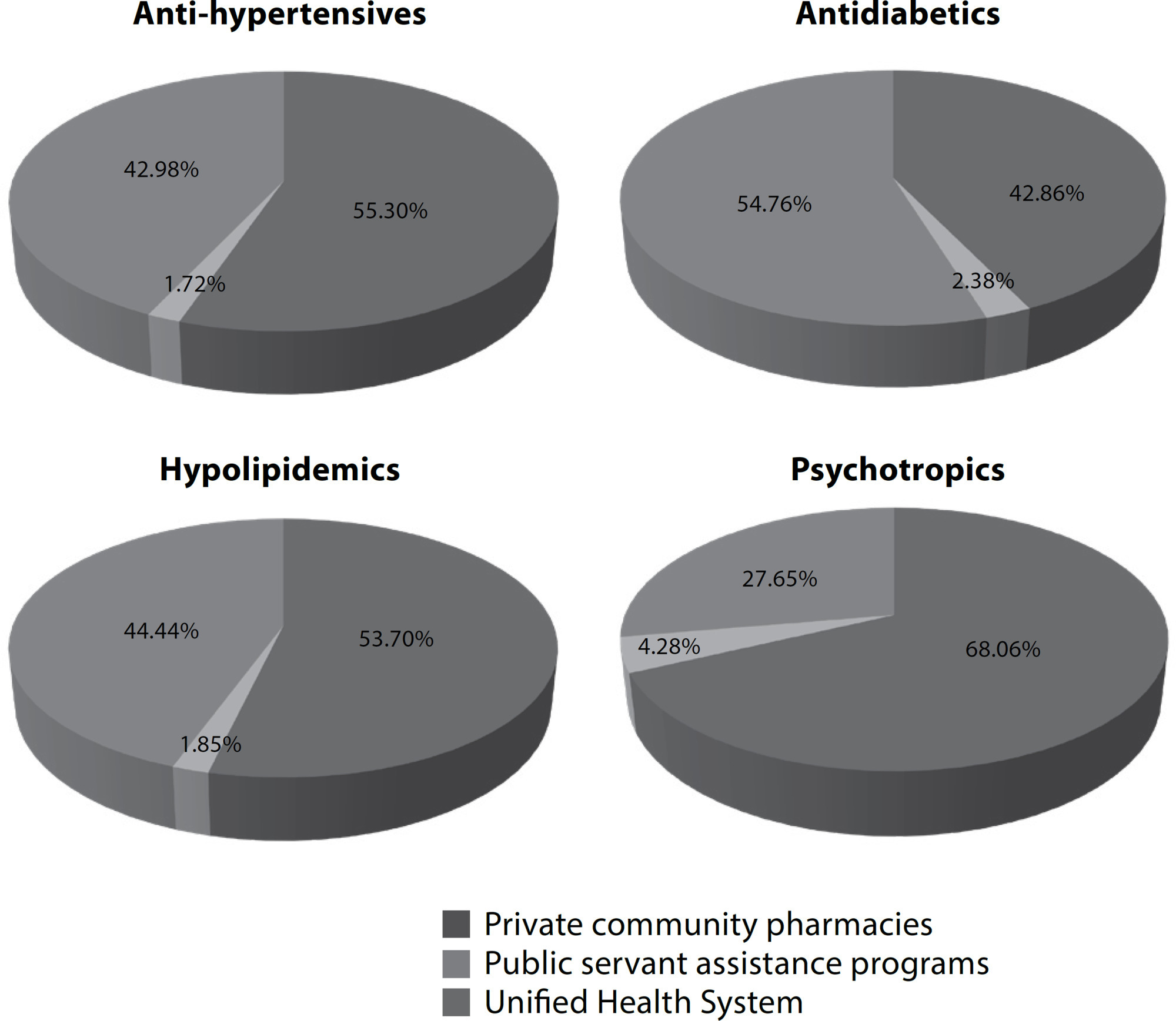
-
REVIEW11-26-2022
Parental burnout: a scoping review
Revista Brasileira de Enfermagem. 2022;75:e20210203
Abstract
REVIEWParental burnout: a scoping review
Revista Brasileira de Enfermagem. 2022;75:e20210203
DOI 10.1590/0034-7167-2021-0203
Views0See moreABSTRACT
Objective:
to map available evidence on parental burnout theme.
Method:
scoping review as according to the Joanna Briggs Institute. Search in January 2021, in six databases of publications in English, Portuguese or Spanish, without time limits. Data extracted and descriptively analyzed by three independent researchers.
Results:
374 articles were identified and 20 were included in the final sample, all published in English, from 2017 onwards. Parental burnout is a complex, multifactorial problem, distinct from burnout cases, depressive symptoms and other mental health alterations. It affects 0.2 to 20% of parents, has validated and suitable instruments for measurement; if not treated, can have consequences on marital life, work relationships, child neglect and violence.
Conclusions:
this is a recent theme that needs to be explored, due to the possible impact on children’s and families’ health and on parents’ work processes. Protocol registered in the Open Science Framework ().
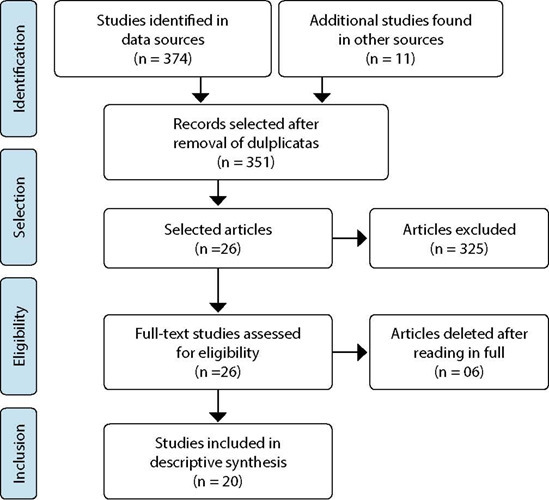
-
EXPERIENCE REPORT06-09-2021
Genograma e ecomapa como estratégias lúdicas de ensino de enfermagem na Atenção Primária à Saúde
Revista Brasileira de Enfermagem. 2021;74(3):e20201106
Abstract
EXPERIENCE REPORTGenograma e ecomapa como estratégias lúdicas de ensino de enfermagem na Atenção Primária à Saúde
Revista Brasileira de Enfermagem. 2021;74(3):e20201106
DOI 10.1590/0034-7167-2020-1106
Views0See moreABSTRACT
Objectives:
to report the experience using ludic strategies for the teaching-learning in the elaboration of the genogram and ecomap; and the use of these instruments by Nursing students in the Primary Health Care services.
Methods:
an experience report of the discipline Integrity of Care I (Integralidade do Cuidado I), of the Nursing School of Ribeirao Preto. Problems scenarios were created to approach the genogram and ecomap, comprising different family arrangements, represented by pedagogic puppets.
Results:
students actively participated, held collective discussions, elaborated genogram, and ecomap, identified the type of family, and the stages of the vital cycle, providing increased dynamics and interactivity. Subsequently, in supervised activities in Primary Health Care services, students elaborated the genogram and ecomap to monitor a family.
Final Considerations:
the use of ludic strategies propitiates the teamwork, active interaction of the group, and the creativity. The articulation between theory and practice resulted in a significant learning.
-
ORIGINAL ARTICLE07-14-2021
Venous ulcer healing treated with conventional therapy and adjuvant laser: is there a difference?
Revista Brasileira de Enfermagem. 2021;74(3):e20201117
Abstract
ORIGINAL ARTICLEVenous ulcer healing treated with conventional therapy and adjuvant laser: is there a difference?
Revista Brasileira de Enfermagem. 2021;74(3):e20201117
DOI 10.1590/0034-7167-2020-1117
Views0See moreABSTRACT
Objectives:
to evaluate the effects of venous ulcer healing in patients after six months of conventional treatment and adjuvant low-power laser therapy.
Methods:
prospective cohort study nested in a randomized clinical trial with 38 patients, allocated into an intervention group (conventional treatment and adjuvant laser therapy) and a control group (conventional treatment). Patients were followed up as outpatients, sociodemographic and clinical variables were collected, and indicators of the outcomes Wound healing: secondary intention (1103) and Tissue integrity: skin and mucous membranes(1101) of the Nursing Outcomes Classification. Generalized estimating equations, Kaplan-Meier tests, and robust Poisson regression were used in the analysis.
Results:
the clinical indicators Decreased wound size and Scar formation showed a statistically significant difference in the intervention group, higher number of healed wounds, lower rate, longer time to relapse.
Conclusions:
laser therapy adjuvant to conventional treatment returned better results in healing and lower recurrence rates after six months of intervention.
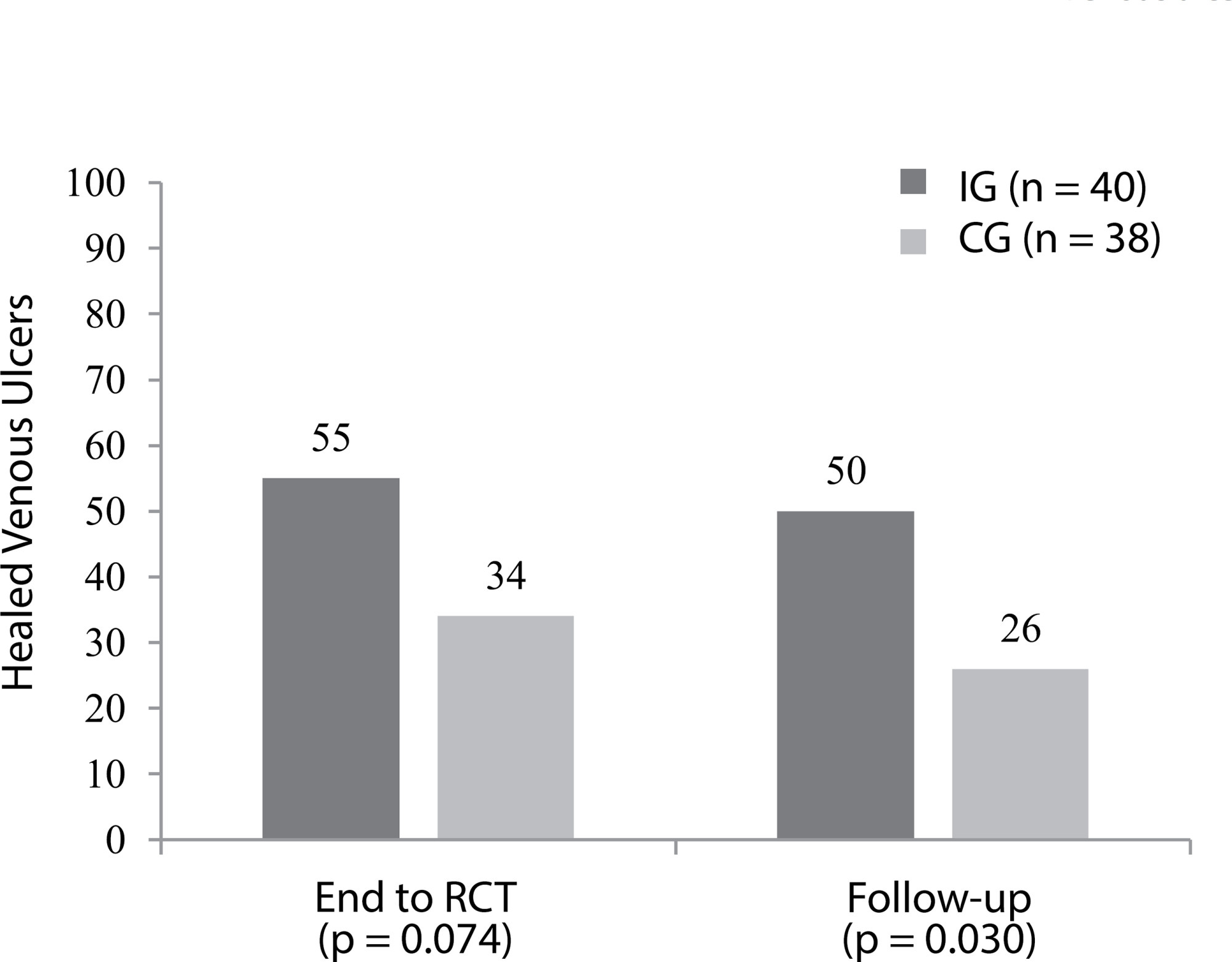
-
REVIEW11-19-2022
Nursing care for bed bath in patients with COVID-19: an integrative review
Revista Brasileira de Enfermagem. 2022;75:e20200704
Abstract
REVIEWNursing care for bed bath in patients with COVID-19: an integrative review
Revista Brasileira de Enfermagem. 2022;75:e20200704
DOI 10.1590/0034-7167-2020-0704
Views0See moreABSTRACT
Objective:
to identify the main nursing care procedures for performing bed bath in patients with COVID-19.
Method:
an integrative literature review. Five stages were followed for this research: research question elaboration (identification of the problem), search of studies in literature, study assessment, data analysis, and presentation of review. To search for primary studies, the VHL and SciELO databases were selected.
Results:
initially, 55 publications were found. After reading and analyzing the abstracts, the sample consisted of 15 studies.
Conclusion:
patients with the new coronavirus have specific care to perform a bed bath, oral, intimate and skin hygiene. It is important that professionals use adequate personal protective equipment, perform humanized care, continuously observing patients’ vital signs to avoid occurrence of adverse events, promoting patient safety.
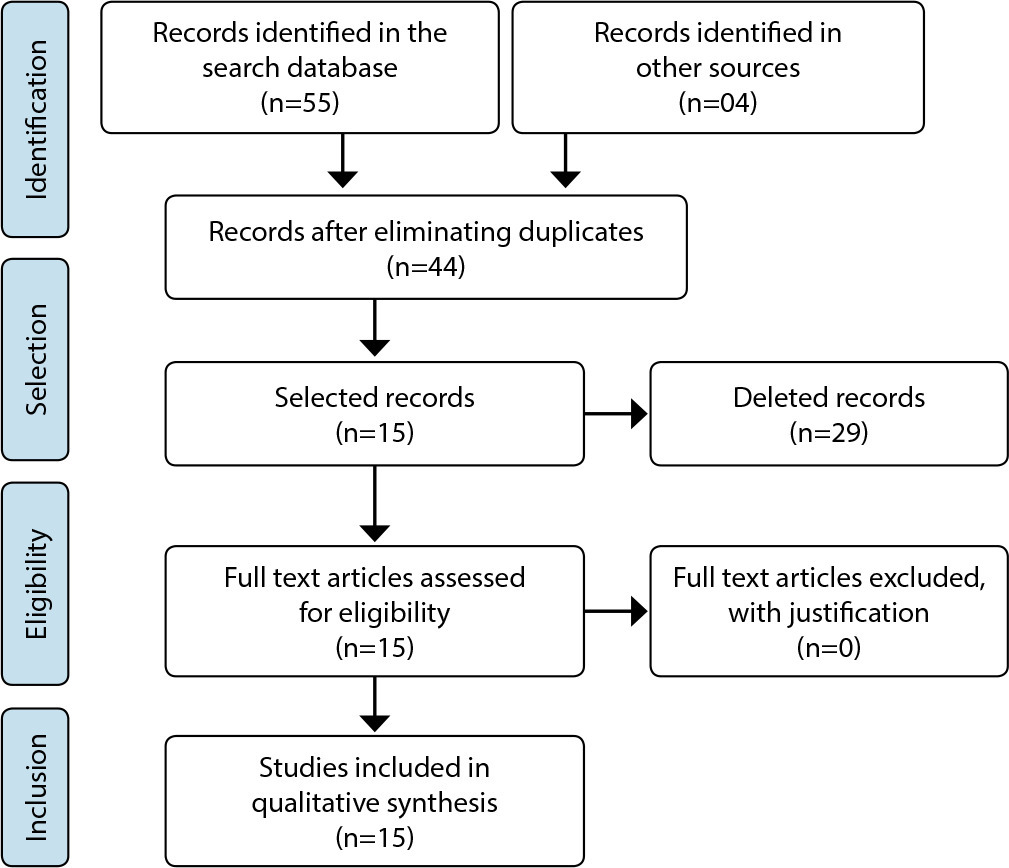
Search
Search in:
Nuvem de Tags
Adolescente (85) Atenção Primária à Saúde (239) COVID-19 (91) Criança (91) Cuidados de Enfermagem (269) Educação em Enfermagem (151) Educação em Saúde (139) Enfermagem (930) Enfermagem Pediátrica (86) Estudantes de Enfermagem (77) Estudos de Validação (131) Família (87) Idoso (208) Promoção da Saúde (99) Qualidade de Vida (104) Saúde do Trabalhador (86) Saúde Mental (145) Saúde Pública (82) Segurança do Paciente (150) Tecnologia Educacional (100)



